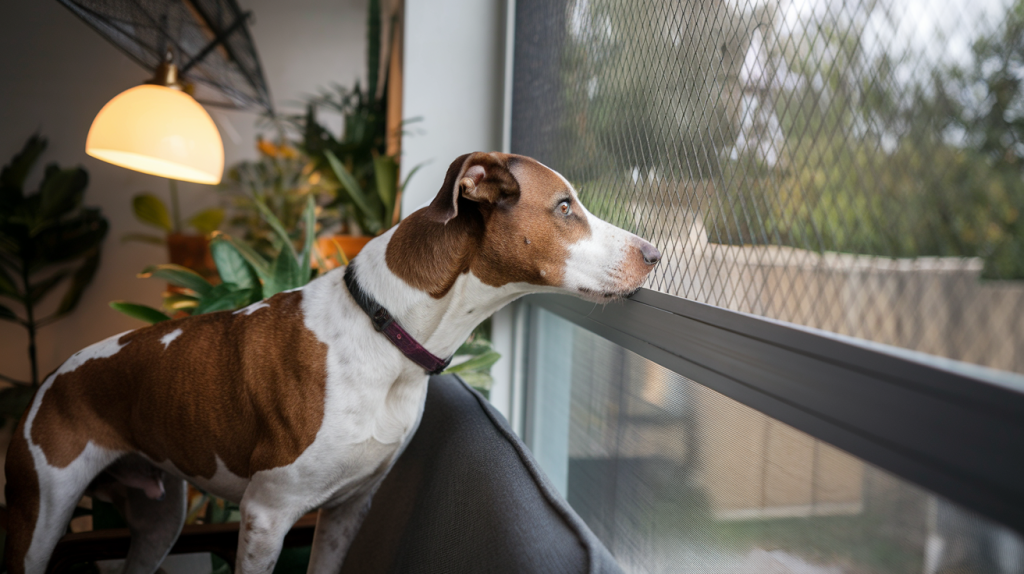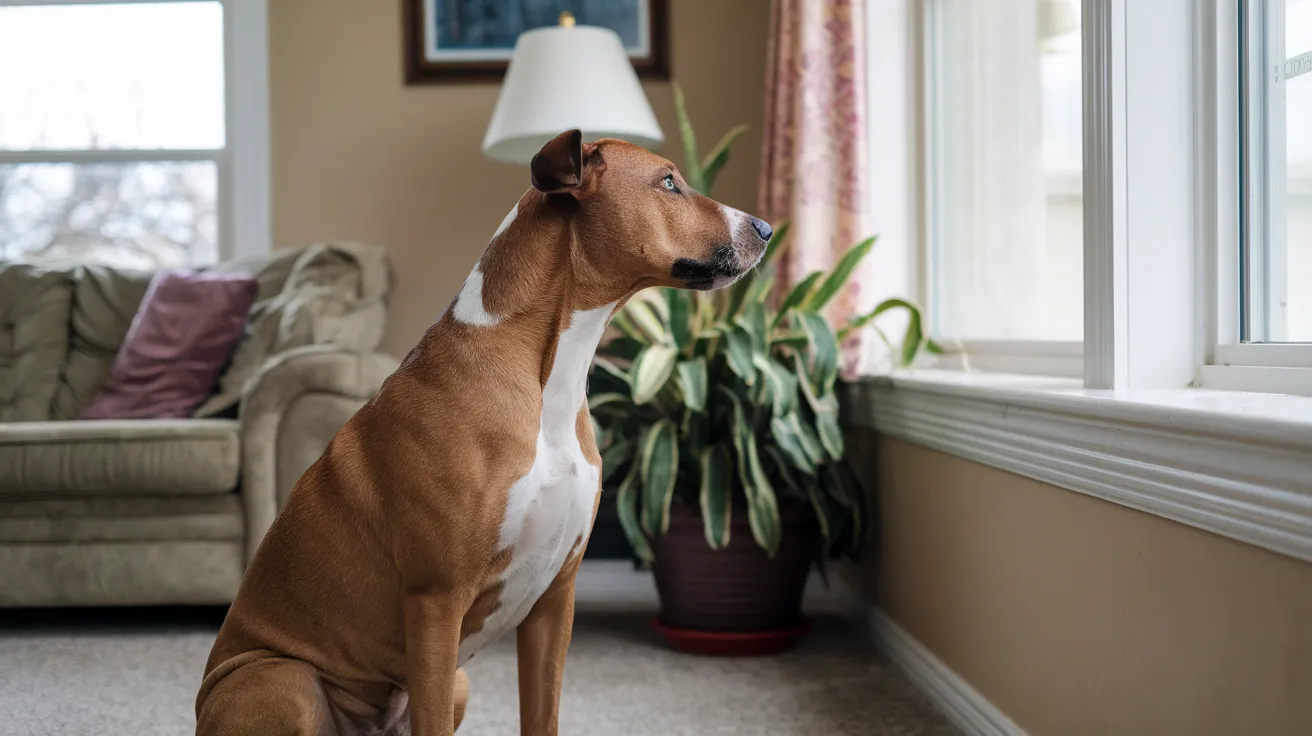Ever wonder why your dog stares out the window like they’re watching the world’s most interesting movie?
If you own a dog, this happens daily at your house. They plant themselves at that glass and won’t budge. Completely absorbed by whatever’s outside. Sometimes they bark at things you can’t even see.
What’s really going through their mind during these window marathons? Are they bored? Planning something? Just being nosy?
Let me show you why do dogs like looking out the window and what’s actually happening when your furry friend becomes a professional window watcher.
The Science Behind Window Watching: Why Do Dogs Do It
Dogs look out the window because it provides them with mental stimulation and environmental enrichment.
Watching the outside world gives them entertainment, helps relieve boredom, and allows them to monitor their territory.
They enjoy seeing people, animals, and activity, and if the window is open, they also get new scents, which are highly stimulating for their powerful sense of smell.
For many dogs, this is like watching TV or socializing from a distance, helping them feel connected to the outdoors and reducing anxiety or negative emotions when they’re indoors for long periods.
However, if a dog becomes frustrated or reactive at the window, it can lead to problem behaviors like excessive barking or barrier frustration, so it’s best managed based on the individual dog’s temperament.
Is It Good for Dogs to Look Out the Window?
Yes, window watching is great for dogs. Looking out windows is healthy and natural for most dogs. It gives them mental exercise and satisfies their basic instincts.
Why it Helps Your Dog
- Mental stimulation: Watching outside activity keeps their brain busy. Moving cars, people, and birds provide free entertainment.
- Stress relief: Window time can calm anxious dogs. It gives them something positive to focus on.
- Natural behavior: Dogs are born to watch and guard. Windows let them do this safely indoors.
- Better sleep: Dogs with enough mental stimulation sleep more soundly at night.
When it Might Be a Problem
Suppose your dog is showing warning signs such as non-stop barking at everything outside, becoming aggressive toward people passing by, or being unable to leave the window even for food.
In that case, it may indicate an unhealthy obsession with window watching.
Additionally, if your dog is panting or pacing while watching, this could be a sign of anxiety or stress.
These behaviors suggest that the window has become more than just a source of curiosity, and it may be affecting your dog’s well-being. It’s important to address these signs to prevent further behavioral issues.
Signs Your Dog Might Be Overdoing It
If your dog spends too much time looking out the window, you may start to notice signs that they’re overstimulated or stressed.
Here are some behaviors to watch for:
- Hyperactivity: If your dog starts running in circles, jumping, or can’t settle down after window watching, it’s a clear sign they may be overstimulated.
- Excessive Barking: Constant barking at people, cars, or animals outside is another sign that your dog is too focused on what’s going on outside.
- Restlessness: Pacing, whining, or not being able to relax after window time shows that your dog is having trouble winding down.
- Inability to Focus: If your dog starts ignoring commands or gets distracted easily after window watching, it may be a sign that they’re overloaded with too much stimulation.
- Aggressive or Anxious Behavior: Growling, lunging at the window, or showing signs of anxiety, such as a tucked tail or flattened ears, are signs that your dog is feeling overwhelmed.
- Destructive Actions: If your dog starts chewing, digging, or tearing things up after spending time by the window, it could be a sign of frustration or stress.
How to Manage or Redirect Your Dog’s Window Watching
To manage or redirect your dog’s window watching, provide mental and physical stimulation through toys, walks, and training, while limiting access to windows.
Consistent redirection and creating a structured routine can help reduce obsessive behavior and keep your dog balanced.
Control What They Can See
To manage window watching, apply frosted film to the bottom half of windows, install partial blinds or curtains during peak activity times, and cover windows that trigger your dog, such as those facing delivery trucks.
These adjustments can help reduce fixation on the outside world.
Create Positive Distractions
Use puzzle toys to engage your dog when they focus too much on the window.
Offer chew toys or special treats during problem window-watching times, and hold training sessions near the window to redirect their attention to you.
Teach the “Quiet” Command
Start small by saying “quiet” when your dog barks once at the window, rewarding them as soon as they stop. Be consistent by having every family member use the same command word.
Always reward immediately with treats and praise when they stop barking.
Set Up Alternative Activities
Create a comfort zone by placing your dog’s favorite bed in a quiet room away from busy windows. Rotate toys to keep some special for times when you need to redirect their attention from the window.
Play interactive games like fetch or tug-of-war to help release energy when they become too wound up from watching.
Use Physical Exercise
More walks help tire your dog out, making them less likely to obsess over window activity. Backyard time allows them to explore the area they’ve been watching.
Dog park visits provide social interaction with other dogs, reducing their fixation on strangers outside.
Train the “Leave It” Command
Practice with treats by teaching your dog the “leave it” command with food, then apply it to window watching.
Use positive reinforcement by rewarding them when they voluntarily look away from the window. Be patient, as this requires time and consistent practice to be effective.
Create a Schedule
Designate 15-30 minutes of supervised window time, then redirect your dog to another activity. Rotate between window watching, walks, meals, and play throughout the day.
Maintaining a consistent routine helps your dog feel more secure by knowing what to expect.
When to Seek Professional Help
You need professional help when basic training fails after several weeks. If your dog ignores “quiet” and “leave it” commands while window watching, the behavior is too deeply rooted for home solutions.
Physical warning signs:
- Constant panting or trembling
- Loss of appetite
- Sleep problems
- Excessive pacing
Aggressive behavior requiring immediate help:
- Scratching windows until bleeding
- Throwing the body against the glass
- Aggression toward family members
- Growling when moved from the windows
Start with your veterinarian. They can rule out medical causes, prescribe medication, and refer you to animal behaviorists or certified trainers.
Don’t wait if your dog has injured themselves, become aggressive, stopped eating, or if intense behavior started suddenly. The longer you wait, the harder it becomes to fix.
Professional help shows good pet ownership. Your dog deserves to feel calm, not obsessed with windows.
Why Do Dogs Like Looking Out the Window? Myths vs. Reality
1. Dogs Look Out the Window Because They’re Lonely
Reality: They’re usually curious and enjoy watching the world outside, not just because they’re lonely.
2. Dogs Look Out the Window to Guard the House
Reality: It’s more about staying alert to movements and changes in their environment, not actively guarding.
3. Dogs Are Waiting for You When They Look Out the Window
Reality: They’re often watching for movement, not necessarily waiting for their owner.
4. Dogs Want to Go Outside When Looking Out the Window
Reality: They’re typically just observing their surroundings, not thinking about going out.
5. Dogs Look Out the Window Because They Want to Escape
Reality: They’re curious, not trying to escape, unless trained otherwise.
6. Dogs Are Always Relaxed When Looking Out the Window
Reality: Some dogs may feel anxious or protective, depending on what they see outside.
The Bottom Line
Your dog’s daily window marathons aren’t weird at all; they’re actually genius. In this blog, we have concluded why do dogs like looking out the window.
So next time you catch them staring outside, don’t interrupt. They’re not being lazy, they’re being smart. Your window-watching pup is taking care of their mental health naturally.
Just make sure they get physical exercise too. The perfect dog day includes both window time and active play.









